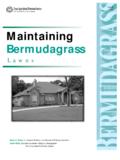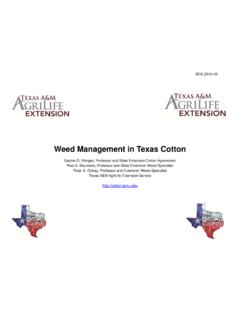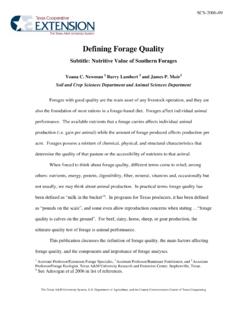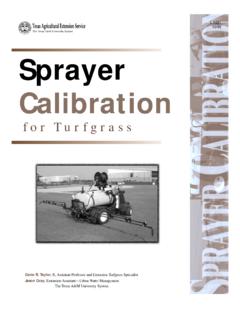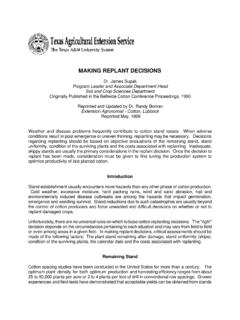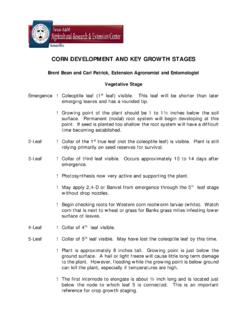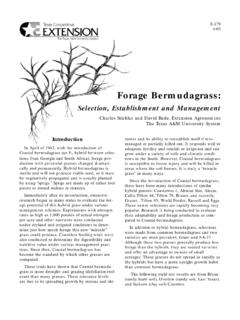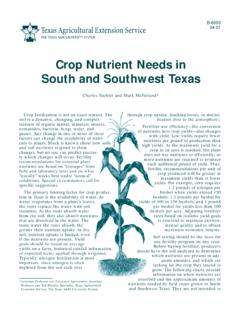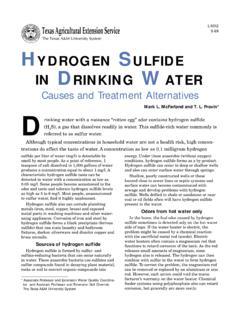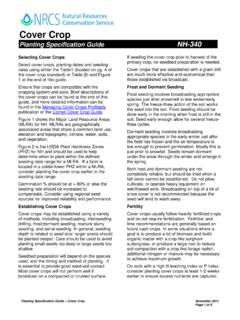Transcription of Haygrazers and Canes for South Texas - Texas A&M University
1 L-5145. Haygrazers and Canes for South Texas S. D. Livingston, D. H. Bade, and D. J. Dorsett*. livestock owners have strived to plan for the a workhorse hybrid providing various levels of grazing of as much established forage as possible to protein, sweetness, drought resistance, and minimize having to feed hay and to supplement with chlorosis tolerance. All of these factors are protein. With coastal bermudagrass, Klein, and important and should be considered in selecting buffelgrass as the pivotal grasses in South Texas , seed for temporary pastures. Many selections may the use of temporary pastures has included small be equally suitable for hay, grazing, greenchop, grains, millets, and various types of sudan and ensilage, and set-aside acreage. Haygrazers . These tropical-derived grasses can be established in the spring and will offer extended and High tonnage that is not accompanied with a high rapid growth for hay or grazing into the hot summer leaf-to-stem ratio and nutritional value (protein and months when bermudagrass has turned dormant.)
2 Energy) is of lower value to livestock . Much of the Haygrazers produced for sale in Texas is cut late Haygrazers are described as crosses of forage (post boot stage/early heading), with tonnage having types of sorghum, sorgo, and sudangrasses. Sudan a greater priority than feeding value. hybrids are described as hybrids or crosses in which at least one parent is a sudan. The other parent may The highest-quality Haygrazers are well fertilized, be a grain sorghum, a sweet sorgo, or a sudan. are produced on deep, well-drained soils for Sorghum X sudan and sorgo X sudan hybrids tend extended moisture supply, and are planted to have coarser stems and broader leaves than the somewhat thicker to decrease stem diameter. The true sudan X sudan hybrids. Common examples of selection of premium-quality cultivars and seed sudan hybrids are Haygrazer, Trudan, Sweet Treat, could also affect production and quality through Sweet Graze, Sudax, and many others.
3 Sudan X improved plant health, lower risk of prussic acid , sudan hybrids usually produce less than sorghum and seed size. The HCN potential of sudangrass and or sorgo X sudan crosses. sudangrass X sorghum hybrids differs with cultivar, stage of growth, level of N fertilization, and The Need for Temporary Pastures. As rainfall environmental conditions. The HCN potential of and soil moisture decline, coastal bermudagrass sudangrass X sorghum hybrids is greater than that will remain green as long as moisture is being of sudangrass cultivars. replenished from the subsoil, but it will not replace what is grazed with new growth. Since June and July Site Selection and Soil Preparation. Soil are typically sparse months for rainfall, Haygrazers should be worked early enough in the season to usually grow so rapidly as to stockpile excellent remove weeds and coarse plant residues and to grazing well into the summer months.
4 If more accumulate moisture in the soil profile. Soil test haygrazer is produced than can be used, the field recommendations are the basis for applying the can be divided with a hotwire, and the ungrazed most effective quantities of fertilizer. These are portion can be baled while it is in the boot stage. based on projected forage yields (tons per acre). or grazing objectives. In the absence of a soil test, Forage Quality. There are a number of Canes , disk- or knife-in 50-30-30 on coarser upland soils or sudans, and Haygrazers to choose from. Most seed 50-20-0 on heavier soils of the coastal plain. companies offer a premium grade, a medium, and *Associate Professor and Extension Specialist, Forage, and Professor and Extension Specialists, Forage and Agronomy, respectively, Texas A&M University Texas Agricultural Extension Service Zerle L. Carpenter, Director The Texas A&M University System College Station, Texas Additional fertilizer (especially nitrogen) should basically an annual, but it is a very weak perennial in be applied after each cutting of hay.
5 The best results growth habit and has limited rhizomes. will be obtained on well-drained, fertile soils. Some hybrids/varieties are more tolerant of high-pH soils Hybrid Pearl Millet: This hybrid will resist and should be considered for problem fields. yellowing (more iron-efficient plant), while being satisfactory for grazing horses as well. It does Planting and Seeding Rate. Seeding rate will not induce eye troubles or digestive problems depend on seed size, percent germination, and experienced with some grazers. Warm soils are desired leaf-to-stem ratio. Higher seeding rates may critical for success (don't plant earlier than April in produce finer stems and greater palatability. Less South Texas ). Some 60 to 70 percent of its growth hay is wasted and more forage is consumed. takes place in the first 90 to 120 days. Pearl Millet is very day-length-sensitive and will finish by Seeding rates range from as low as 12 to 15 September.
6 It should be planted in the spring as a pounds per acre (Sorghum Almum) to as high as warm-season annual. Since there is good uniformity 70 to 80 pounds for some sorgo-sudan crosses. in the size of millet seed, plant 5 pounds per acre if Grazers and pearl millets germinate poorly when the plantings are in rows and 12 to 20 pounds per soils are too hot or too cool. Germination is best acre for broadcasting. Millets do not produce between 68 and 86 F. Except for millet, seeding is prussic acid . normally accomplished between March 15 and June 1, but soil temperature should be the guide for early Sudangrasses: True sudangrasses may be finer planting dates. Millets are day-length-sensitive and stemmed, leafier, and of better quality than many of should be planted after April 1. Adequate planting the Haygrazers . Seeded at 25 pounds per acre, moisture may reduce the calendar dates available sudangrasses generally produce less tonnage than for successful establishment during dry springs.
7 Sorghum or sorgo crosses, but have lower prussic Haygrazers can be dry-planted, but emergence may acid when small. Many have been bred for resistance be uneven or stands may fail if adequate rainfall is to downy mildew, MDMV, and greenbugs. not received soon after emergence. Grazers may Sorghum or Sorgo-Sudan Crosses ( Haygrazers ): also be planted in the fall for quick forage There are premium and non-premium types to production. choose from, depending on type of production desired. Premium types tend to have higher energy Hybrid Selection. and protein, are smaller-seeded, and are planted Redtop Cane: This is a sorghum-cross also more heavily. known as Early Sumac. It provides lots of bulk and Many have early vigor and regrowth, downy is moderately fast in growth, but it has prussic acid mildew and MDMV resistance, and longer season when short (less than 6 inches in height).
8 Redtop maturity. A few crosses (4 Ever Green) are extremely cane is good on land with high pH and land high in slow and require 150+ days to heading. If planted calichi. It should be seeded at about 50 to 60. after March 15, only 10 to 15 percent of these will pounds per acre. Redtop cane was one of the first head out. Canes used for forage in early pastures. Sweet Sorghum Crosses: These include some Orange Cane: This hybrid is also called sourless sorghum-sorgo-sudan grass (3-way crosses) and orange cane or African Millet. It is produced in sorgo-sudan crosses (2-way). The sorgo imparts Arkansas, Kansas, and Texas and can be obtained some additional sweetness, which increases through local seed companies. Rapid emergence consumption and palatability. Fast regrowth, and early growth are important characteristics. Plant drought tolerance, and good disease-resistance 15 pounds per acre if grown in rows and 40 to 50.
9 Packages will ensure multiple cuttings under pounds per acre for broadcasting. favorable conditions. Sorghum Almum: This sorghum looks like Hegari: Hegari has a head-type similar to kafir, Johnsongrass when growing and will volunteer and its seeds are chalky or starchy-white. Leaves are back. Wildlife like it, and it is very easy to establish. more abundant, and the sweeter juice makes it more Planted at 12 to 15 pounds per acre, it provides lots prized as a forage. Planting rates are the same as for of bulk with very fast production. Sorghum Almum is grazer seed. Hegari works well on shallow soils that Crops planted in rows for grazing can experience tend to be chlorotic. It is an older, workhorse type weed competition. Huisache, johnsongrass, and forage that has good drought tolerance and average shattercane off-type plants are most common. regrowth.
10 It does not have the disease resistance Limited broadleaf plants may be a problem where that has been bred into our current grazers and thin stands are achieved and no herbicide has consequently has evolved to a lower-class forage been used. that is placed on less-productive soils. Its popularity is as a forage, a hay crop, and a game (bird) feed. Harvesting. Many Haygrazers achieve heights of 6 to 7 feet under excellent growing conditions. Ideal Variety Not Stated: Producers should not plant plant height may be as low as 20 inches for the seed without variety identity and knowledge of the hybrid sudangrasses (such as Trudan) or much variety's characteristics. taller for most other sorghum-sudan crosses. As previously discussed, harvesting forage as plants Off-Type Plants. These are often plants with are in the boot stage or are just beginning to head is different headtypes, plant heights, or colorings.
